2.
GHANA
GFC in discussions with industry to review timber fees
The Forestry Commission of Ghana (GFC) is consulting
with the timber industry on an upward revision of the
Timber Rights Fee (TRF), also known as the Timber Fee.
This is the annual rent that companies pay for their forest
concessions.
This fee has remained unchanged since 2005 so a
review committee is being set up. This was made known
by Mr. Robert Wilson, The Corporate Manager, Public
Relations of the GFC.
The fee is an annual rent paid by loggers on their timber
concessions and the upward revision that is expected will
generate more revenue for the State for various timber and
forest development projects in the country.
The Office of Administrator of Stool Lands (OASL) and
the GFC are responsible for the management of the
proceeds on behalf of stools / landowners.
While the GFC manages the Forest and collects revenue,
the OASL ensures that the stool /landowners receive their
share in the context of the prevailing laws on
disbursement.
Bank of Ghana considers Chinese Yuan as additional reserve currency
The Bank of Ghana has announced that it will invest in
emerging market securities. For some time there has been
a debate on whether the Chinese currency should be
included because of the growing Chinese investment and
economic cooperation. It now appears that a decision has
been taken by the Bank of Ghana to proceed and include
the Yuan in its portfolio.
Ghana strengthens maritime security capacity
In order to be better equipped to combat piracy and
generally improve maritime security the Ghana navy has
acquired four new Chinese-built patrol ships.
Piracy off the coast of West Africa has been on the rise
and acquisition of these new vessels will enable the Ghana
navy to respond to any maritime threat.
Floods in Accra brings business to a halt
Accra, Ghana¡¯s capital, as wells as some other parts of the
city have been hit by severe flooding following heavy rain.
Media reports talk of the Kwame Nkrumah circular road
being underwater preventing normal business activities.
The floods have caused serious damage to property but, as
yet, there are no reports of damage to wood processing
plants.
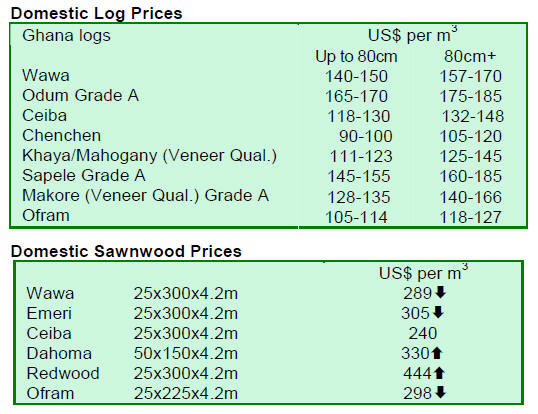
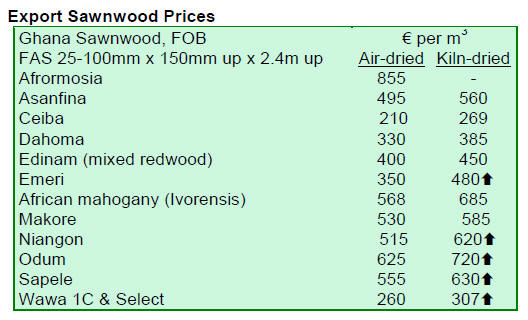
3.
MALAYSIA
MTCS rejected for Dutch government procurement
In 2010, the official Dutch government timber
procurement body TPAC judged that the Malaysian
Timber Certification System (MTCS) does not meet the
Dutch procurement criteria for wood.
On 19 October 2011, the Board of Appeal of Stichting
Milieukeur (SMK), an independent panel, rejected the
Malaysian Timber Certification Council¡¯s (MTCC) appeal
against this decision.
The UK Timber Trades Journal suggests that the main
reason for TPAC¡¯s rejection of MTCS is what it claims is
the scheme¡¯s limited recognition of the rights of
indigenous peoples and lack of adequate protection against
the conversion of certified natural forest to other uses,
including plantations.
The SMK appeals panel said MTCC had not provided
substantive arguments in their case. ¡°The result is that the
MTCC Board¡¯s action is on all counts dismissed,¡± it said.
An MTCC spokesperson said it regretted the decision,
which it said undermined the efforts by developing
tropical forest countries like Malaysia to implement timber
certification.
¡°As a voluntary timber certification scheme that has been
developed through a Malaysian multi-stakeholder process,
the MTCS is unfortunately held responsible by SMK for
issues that are inherent to the Malaysian constitutional,
legal and political system,¡± said MTCC chief executive
Chew Lye Teng.
¡°Secondly, the SMK unfortunately chose not to take into
consideration the additional measures to address the TPAC
concerns that have been agreed between MTCC and the
Dutch State secretary Joop Atsma.¡±
¡°Contrary to the SMK ruling, the Danish, British, French
and UK governments and the German municipality of
Hamburg have recognised the MTCS as providing
assurance of sustainable timber,¡± said the MTCC.
The Netherlands is the largest market for Malaysian
timber in the EU. In 2010, Netherlands imported around
100,000 cu.m of hardwood lumber from Malaysia.
The Netherlands accounts for 49% of exports of MTCS
certified timber products.
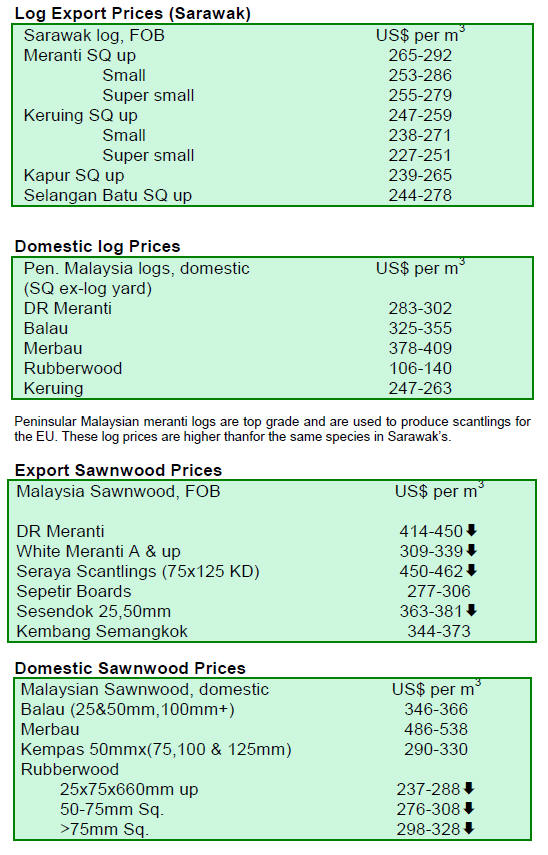
4.
INDONESIA
Nigeria makes presence felt at Expo
Indonesia
Indonesia attracted around US$351 million in trade
agreements and orders at the 26th Trade Expo Indonesia,
the country¡¯s largest trade exhibition, held from October
19th to October 23rd. Most of the new business was for
furniture products report analysts.
Nigerian businesses led the way with some US$38 million
worth of orders, followed by Malaysia (US$32 million),
the UK (US$26 million) and Belgium with US$20 million.
It was reported that Nigerian businesses were the
biggest
buyers at this trade show accounting for 11% of all
transactions.
Interim statistics show that at 6,391 buyers from 89
countries attended and participated in the exhibition. The
organizers are forecasting final attendance figures of
around 8,300.
Indonesia faces risks from the EU debt crisis and
economic stagnation in the US
The Indonesian Chief Economic Minister has said that he
was still optimistic that the Indonesian economy could
achieve a 6.5% growth in 2011 and may reach 6.7% in
2012, barring any negative global economic impacts.
He added that an IMF report indicated that Asia
continues
to face adverse risks arising from the EU debt crisis and
economic stagnation in the US.
The IMF indicted that economic growth in Asia will
hover
around 6.3% in 2011 and 6.7% in 2012.
Nevertheless, the Indonesia government will continue to
monitor and take pre-emptive measures in the face of any
possible impact from declining world economic growth in
2012, the Minister added.
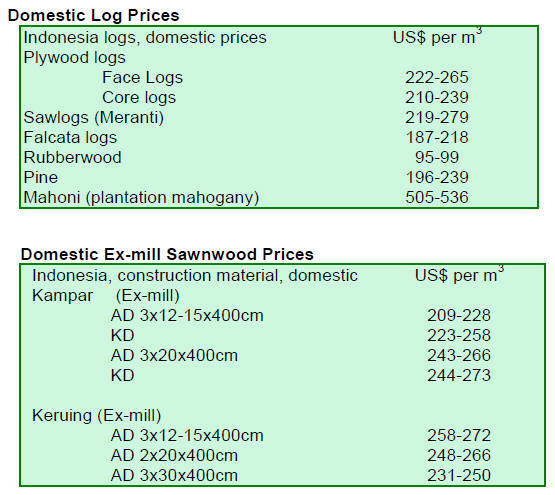
5. MYANMAR
Myanma Timber Enterprise profile
The Myanma Timber Enterprise (MTE) reports that there
are some 91 state-owned sawmills in Myanmar. Ten of
these mills are producing for export. In addition to the
state-owned mills there are over 450 small and medium
sized sawmills and around 1,200 reprocessing mills.
The SMEs are privately owned wood processing plants
and mainly produce furniture and other semi-finished
products.
In addition, the MTE reports that it has six plywood
mills
and several furniture and moulding plants for the
production of wood products for export.
While there are some modern mills in the country the
MTE points out that many mills need re-tooling with more
advanced processing equipment.
As a result, says the MTE, the current milling
capacity is
well below the annual allowable harvest which means
there are logs available for export.
For more see:
http://www.myanmatimber.com.mm/
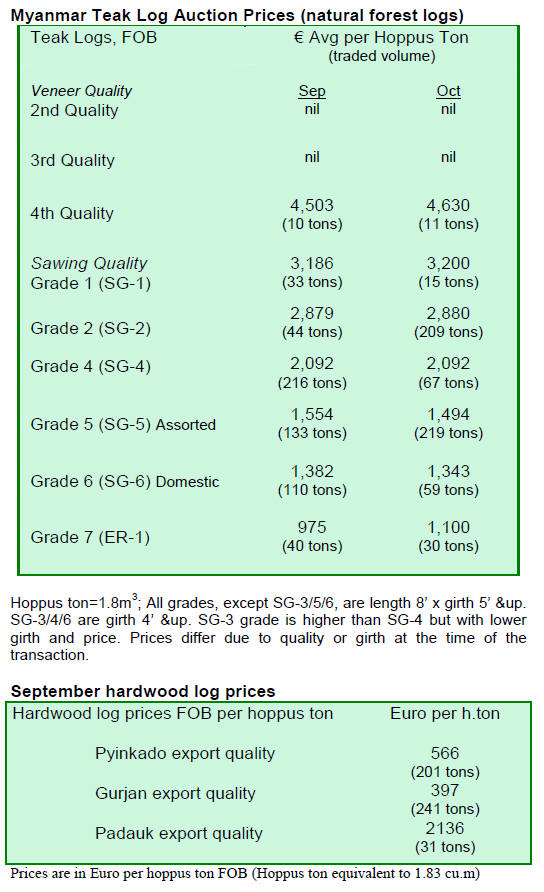
6.
INDIA
Domestic log prices firm as
imported log prices climb
With the monsoon rains having receded in most parts of
India log auctions have restarted in Central and Western
depots.
Approximately 3,500 cu.m of teak logs were sold in
South
Gujarat depots recently. Most of these logs were from premonsoon
harvests but, despite these being considered old
logs, prices in rupee were firm as the cost of imported logs
has been rising. In terms of dollars, prices remained at
levels seen in previous auctions of old stock and sales
were brisk.
Prices for non-teak logs have also been rising and
the
market is expected to continue on a firm trend in the
coming months say analysts.
Freshly felled logs have started to arrive at the
log depots
and will be auctioned after the Deepawali holidays.
Signs that Indian manufacturing output is slowing
India¡¯s exports maintained a robust growth rate despite the
prospects of a decline in the months ahead due to
European and American economic problems.
The EU and the US are the biggest markets for India
accounting for about 30% of all shipments.
In the first half of the year exports recorded a 52%
increase to US$160 billion. In contrast, imports have been
falling and only grew by 36% during the same period.
During September 2011 import growth fell 17% compared
to figures for September 2010.
Though there are signs that manufacturing output is
slowing, government sources are hopeful of achieving a
GDP growth rate of around 8.2% for the year.
A new name added to the list of well equipped
furniture manufacturers
Over the years, modern and well equipped furniture
factories have been established in India such as those of
Godrej, Featherlite, Zuari, Wipro, Reliance and Durian.
New names are being added to the list and the latest
is
Coffee Day Group (CCD chain) which is reported to have
made arrangements to import large quantities of tropical
hardwood from the Republic of Guyana.
Raw material will be shipped to Mangalore and used
for
the manufacture of a wide range of furniture at the
company¡¯s Chikmaglur plant.
Presently the company uses Silver Oak, Teak,
Rosewood
and other hardwoods, some of which come from areas
within the company¡¯s coffee estates around Chikmaglur.
These timbers are used for faced plywood and other faced
panel products as well as for furniture.
Discounts on consumer durables attracts hesitant
consumers
After several months of depressed retail sales in the run up
to the Deepawali holidays, sales of consumer durables
have picked up say analysts.
Reports suggest that furniture and other showrooms
are
busy but have had to offer big discounts to stimulate
demand.
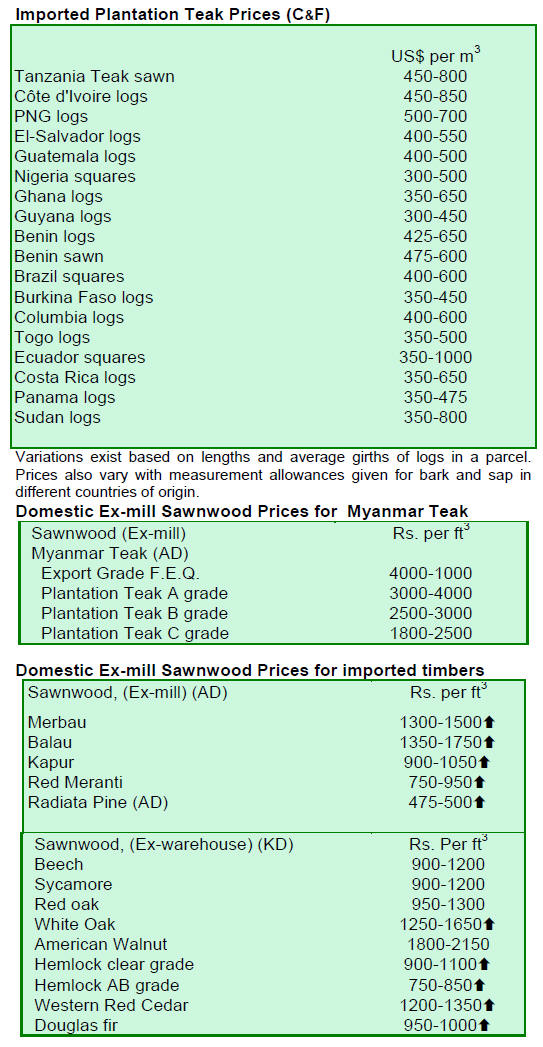
7. BRAZIL
September exports drop across the board
In September, exports of wood products (except pulp and
paper) fell 4.7% in value compared to levels in September
2010, that is from US$206.4 million to US$196.8 million.
Pine sawnwood exports declined 11.5% in value in
September compared to the same month in 2010, dropping
from US$14.8 million to US$13.1 million. In terms of
volume, exports dropped 13.0%, from 64,700 cu.m to
56,300 cu.m over the same period.
Exports of tropical sawnwood also fell in volume
and
value, from 51,300 cu.m in September 2010 to 39,400
cu.m in September 2011 and from US$23.8 million to
US$21.5 million, over the same period. This performance
corresponds to a 9.7% drop in value and 23% drop in
export volumes.
Pine and tropical plywood export performance
disappointing
Pine plywood exports declined 15% in value in September
this year compared to levels in September 2010, from
US$24.8 million to US$21.1 million. Export volumes
were down 20% over the same period, from 67,500 cu.m
to 53,900 cu.m.
Similarly, exports of tropical plywood crashed from
8,300
cu.m in September 2010 to just 6,000 cu.m in September
2011, representing a 28% drop. In terms of value, the
decline was in the order of a 25% from US$4.8 million to
US$3.6 million.
The bad news continues with declines in wooden
furniture exports
Wooden furniture exports which fell from US 49.2 million
in September 2010 to US$41.6 million in September this
year representing a 15.4% decline in exports during the
period.
Timber industry urging Mato Grosso State
government to reconsider tax increase
Representatives from the Mato Grosso Center of Wood
Producers and Exporters (CIPEM) are discussing with the
Mato Grosso State government the increase in the Fiscal
Unit Standard (the index that updates the taxes charged by
the Brazilian States). A recent decision by the State
increased the rate to 31.5%.
This tax adjustment, says CIPEM, is having a
negative
impact on the timber sector as it has pushed up the cost of
wood raw materials.
The Fiscal Unit Standard, which was R$36.03 went up
to
R$46.83 which means that prior to the change the state
government used to collect 7.4% as a forest products
transport document services fee, today under the new
rules, the rate collected has risen to 11%.
CIPEM contacted the Mato Grosso State Secretariat
of
Environment (SEMA) to negotiate a reduction in the tax
rate on services.
Furniture industry benefits from BNDES credit line
The Brazilian Development Bank (BNDES) reported that
in the past 12 months around 500,000 transactions were
made through the BNDES Card worth R$ 7.2 billion. In
the same period, retailers and furniture manufactures made
27,000 transactions (5.4% of total) worth R$308.8 million
(4.2%).
The BNDES card is a credit line launched in 2003,
designed especially for micro, small and medium-sized
enterprises.
This credit line is pre-approved for companies with
gross
annual revenues of up to R$ 90 million. The credit limit is
R$1 million through the Bank of Brazil, Banrisul,
Bradesco, Caixa Economica Federal and Ita¨² Bank.
Repayment terms are up to 48 months and the interest rate
charged is 0.97% per month.
Purchases of raw material from distant States
driving
up production costs in Mato Grosso
Log harvests in the state of Mato Grosso totaled 1,045
million tons in the period January to September this year
and of this volume around 6% were utilised for the
production of wood products for export.
In addition to the raw materials provided from
State
resources, some sectors of the timber industry in Mato
Grosso have been purchasing wood products from other
regions of Brazil.
Most of these raw materials come from mills in Mato
Grosso do Sul, Parana and Sao Paulo States where
plantation timbers are used for OSB and MDF production.
The Furniture Industry Union of Mato Grosso
(Sindim¨®vel) has said that the purchase of raw materials
from other States for furniture manufacturing began due to
the difficulty in securing raw materials locally but this is
resulting in increased costs of production.
Delays in the release of imported Brazilian
furniture by
Argentinean authorities hampering trade
Furniture exporters in Brazil are complaining that delays
by Argentinean authorities in releasing from Customs the
imports from Brazil are hampering trade. Exports from
Brazil to Argentina from January to September fell 18%
compared to levels in the same period in 2010.
The World Trade Organization (WTO) norm for the
release of exports is 60 days but, according to the
Association of Furniture Industries of Rio Grande do Sul
(Movergs), Argentina is exceeding this norm and that
some exported products have not been released by
Argentinean authorities for almost twelve months.
Brazilian currency depreciates slightly against
the US dollar
According to the Brazilian Institute of Geography and
Statistics (IBGE) the National Consumer Price Index
(IPCA) rose 0.53% in September up from the level in
August (0.37%).
The cumulative rate over the past 12 months is now
7.31%
and this is above the government¡¯s goal which is 6.5%.
The average exchange rate for the Real against the US
dollar rate in September was BRL 1.75, while in the same
month of last year was BRL 1.72 signaling a slight
depreciation of the Brazilian currency against the US
dollar.
The Central Bank¡¯s Monetary Policy Committee (Copom)
decided to reduce the Selic rate by 0.50% to 11.5% and
this accelerated the pace of falling interest rates that began
in August. The next Copom meeting is scheduled for late
November.
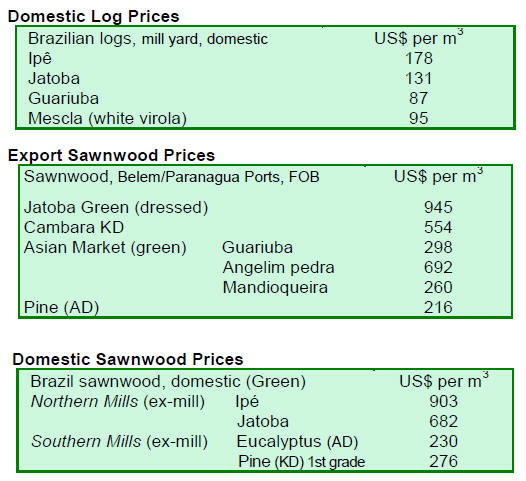
8. PERU
China reduces timber imports from Peru
According to data from the Export Association of Peru
(ADEX), wood product exports between January and
August this year totalled US$108 million FOB compared
to the US$114 million in the same period last year, a
decline of around 5%.
Up until the end of August the three main export
markets
were China, Mexico and the United States and these three
markets accounted for 76% of the wood sector exports.
Among the countries that reduced imports from Peru
were
China and Italy. China¡¯s imports of sawnwood fell
sharply.
Added value products 40% of all wood product
exports from Peru
Semi-manufactured product exports up to August, at US$
42.7 million FOB, represented 40% of the value of all
wood product exports, down from the US$52.1 million in
the same period in 2010.
Sawnwood exports were the second largest and
represented around 35% of all wood product exports.
Exports of sawnwood up to August were US36.6
million
FOB, down 8% when compared to the US$39.6 million
exported in the same period in 2010. The main market for
sawnwood from Peru was Mexico which accounted for
43% of total sawnwood exports.
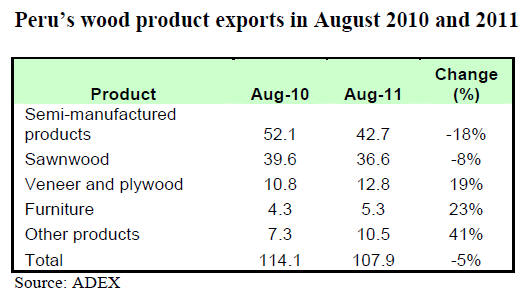
Mexico the major market for veneer and plywood
Between January and August this year exports of veneer
and plywood were valued at US$12.8 million FOB, up
12%. Some 70% of all veneer and plywood exports from
Peru were destined for Mexico. This year Ecuador has
emerged as a new export market for plywood and veneer
from Peru.
Furniture and furniture parts exports post hefty
gains
in a gloomy market
Furniture and furniture parts exports were worth US$5.3
million FOB up 23% on the performance in the same
period last year. The main markets for these products
were the US and Italy.
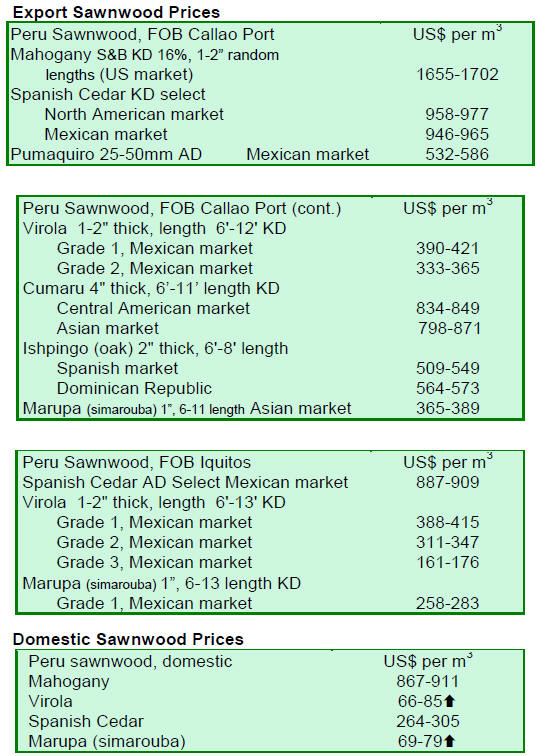
9.
GUYANA
Timber enterprises benefit
from commissioning of new kiln
With the recent commissioning of a new wood-drying kiln
at least 32 enterprises in Linden in Guyana¡¯s Region 10
are expected to benefit.
This kiln drying plant was funded by the
International
Tropical Timber Organisation. One of the enterprises in
the Region 10 Forestry Group responsible for managing
the facility said it will be open to all the 32 Forestry Group
members in Region 10 as well as other companies.
This investment could pave the way for the further
development of the wood processing sector in the Linden
area.
The Government of Guyana is working to diversify
employment opportunities for the people in Linden and
wood processing is one of the sectors identified as new
economic activities.
The Guyana Forestry Commission, along with the
Forest
Products Development and Marketing Council of Guyana,
has been promoting kiln drying as an essential element in
the development of downstream processing.
Purpleheart log exports earn valuable foreign
exchange
During the period under review no Greenheart logs were
exported. However the export of Purpleheart logs made a
contribution to overall export earnings. Purpleheart
Standard sawmill quality log prices increased compared to
levels reported earlier.
In contrast, Purpleheart Fair and Small sawmill
quality log
prices remained unchanged. Mora logs were exported and
Standard sawmill quality logs were at the same price
levels as previously reported.
On the other hand Fair and Small sawmill quality
Mora
logs were in good demand and prices remain firm.
Market demand for Guyana¡¯s sawnwood sustained
Exports of sawnwood made a notable contribution to total
export earnings for this period. Undressed Greenheart
(select) prices were maintained.
There were some price increases for Undressed
Greenheart
Sound and Merchantable qualities and prices were
generally favourable.
Prices for Undressed Purpleheart Select quality
fell in the
period under review from US$1,050 to US$912 per cubic
metre. However Undressed Purpleheart (merchantable
quality) received better prices with its top-end prices
moving to US$650 per cubic metre.
Undressed Mora (Select and Merchantable qualities)
sawnwood prices remained unchanged on the export
market in comparison to previously reported levels.
Dressed Greenheart sawnwood prices experienced a
dip
from US$933 to US$848 per cubic metre, while Dressed
Purpleheart sawnwood enjoyed attractive prices on the
export market rising from US$912 to US$996 per cubic
metre.
Plywood prices improve in the Caribbean markets
Baromalli plywood was exported in BB/CC quality and
secured favourable prices as high as US$708 per cubic
metre in the main market for this product, the Caribbean.
Roundwood products secure firm prices
Other roundwood products such as piles and posts
attracted good prices on the export market. The top-end
price for piles wasUS$464 per cubic metre. Posts also
achieved favourable export prices as much as US$735 per
cubic metre.
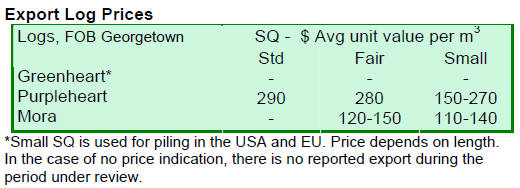
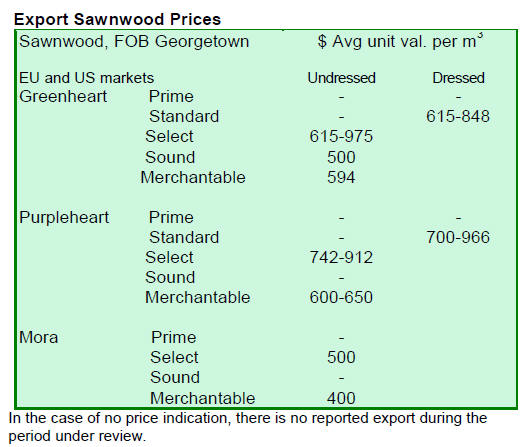
Related News: